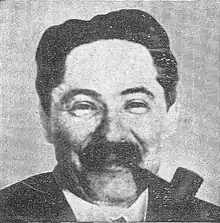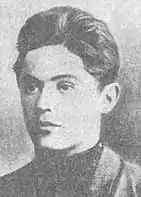Dmitry Manuilsky
Dmitriy Zakharovich Manuilsky or Dmytro Zakharovych Manuilsky (Russian: Дми́трий Заха́рович Мануи́льский; Ukrainian: Дмитро Захарович Мануїльський; 3 October 1883 – 22 February 1959) was an important Bolshevik revolutionary, Soviet politician and academic who was Secretary of the Executive Committee of Comintern, the Communist International, from December 1926 to its dissolution in May 1943.
Dmitriy Manuilsky | |
|---|---|
Дмитро Мануїльський | |
 | |
| First Secretary of the Communist Party of Ukraine | |
| In office 15 December 1921 – 10 April 1923 | |
| Preceded by | Feliks Kon (acting) |
| Succeeded by | Emanuel Kviring |
| Permanent Representatative of the Ukrainian SSR to the United Nations | |
| In office 1945–1952 | |
| Preceded by | Office established |
| Succeeded by | Anatoliy Baranovsky |
| Full member of the 12th, 13th, 14th, 15th, 16th, 17th, 18th Central Committee | |
| In office 25 April 1923 – 16 October 1952 | |
| Candidate member of the 11th Central Committee | |
| In office 2 April 1922 – 25 April 1923 | |
| Personal details | |
| Born | 3 October 1883 Sviatets, Russian Empire (now Ukraine) |
| Died | 22 February 1959 (aged 75) Kyiv, Ukrainian SSR, Soviet Union (now Ukraine) |
| Resting place | Baikove Cemetery |
| Political party | RSDLP (Bolsheviks) (1904–1918) Russian Communist Party (1918–1954) |
| Alma mater | University of Paris |
| Awards | (×3) |
Early life and career

Manuilsky was born to a peasant family of an Orthodox priest in the village of Sviatets. After secondary school, he enrolled at the University of St. Petersburg in 1903, and joined the Bolshevik faction of the Russian Social Democratic Labour Party in 1904.[1] During the 1905 revolution he was assigned by the Bolsheviks to the naval base in Kronstadt where he took part in the naval revolt in July. Arrested, he was held in Kronstadt prison in 1905–06, then exiled, but escaped, arriving in Kiev and then, in 1907, to Paris. There he aligned with the ultra-left group led by Alexander Bogdanov, who challenged Lenin for the leadership of the Bolsheviks, and worked on the newspaper Vpered (Forward). After the outbreak of war in 1914, he worked on the newspaper Nashe Slovo and acted as the main contact between the Bolsheviks and the smaller group associated with Leon Trotsky. After his return to Russia in May 1917, he joined Trotsky's group, the Mezhraiontsy, who amalgamated with the Bolsheviks in August 1917.
In the Soviet Union
.jpg.webp)
During the Russian Civil War, Manuilsky worked in the People's Commissariat for Food, before being sent to Ukraine, where Lenin assigned him the task of organising the peasant population around Kharkiv to defeat the White Army of Anton Denikin. In January 1919, he and Inessa Armand were sent to Paris, in the hope they could stoke a revolution in France, but he was arrested and deported. He was People's Commissar for Food in the Ukrainian Soviet Socialist Republic from 1920 to 1921, then switched to journalism, and from 1922 was working for the Comintern.
From 1923 to 1952 he was a member of the Central Committee of the Communist Party of the Soviet Union, as well as a member of the elite inner circle known as the "malaia comisiia", a five-member group that ruled the eleven-member Political Secretariat.[2] In 1926, he supplanted Nikolai Bukharin as leader of the Soviet Union delegation on Comintern's executive, and the lead representative at congresses of the French, German, and Czechoslovak communist parties.[3]
From 1935 until the dissolution of Comintern in 1943, he acted as deputy to its General Secretary, Georgi Dimitrov. Between 1944 and 1952, he held the largely meaningless post of Foreign Minister of Ukraine. From 1952 to 1953, he was Ukrainian ambassador to the United Nations.
Later life and career
During the Great Purge, almost every Old Bolshevik with a past link with Trotsky was killed or imprisoned, except Manuilsky, whom Stalin despised but by whom he did not feel in any way threatened. In 1939, he told Dimitrov: "Manuilsky is a toady! He was a Trotskyite! We criticised him for keeping quiet and not speaking out when the purges of Trotskyite bandits were going on, and now he has started toadying!"[4] The Montenegrin communist Milovan Djilas, who met Manuilsky in 1944, admired his learning and writing talent, but remembered him as "a slight and already hunched veteran, dark-haired, with a clipped moustache [who] spoke with a lisp, almost gently and – what astonished me at the time – without much energy." Seeing him again five years later, Djilas thought him an "almost senile, little old man who was rapidly disappearing as he slid down the steep ladder of the Soviet hierarchy."[5]
See also
References
- Manuilsky's biography from a 1920s edition of the Great Soviet Encyclopaedia is in translation in Haupt, Georges, and Marie, Jean-Jacques (1974). Makers of the Russian Revolution. London: George Allen & Unwin.
{{cite book}}: CS1 maint: multiple names: authors list (link) - Ton That Thien (1990). Ho Chi Minh and the Comintern (PDF). Singapore: Information and Resource Center. p. 21. ISBN 978-9810021399. Retrieved 20 December 2017.
- Makers of the Russian Revolution: Biographies of Bolshevik Leaders. Ithaca, NY: Cornell University Press. 1974. ISBN 978-0801408090. Retrieved 21 December 2017.
- Dimitrov, Georgi (2003). The Diary of Georgi Dimitrov. New Haven: Yale U.P. p. 104. ISBN 0-300-09794-8.
- Djilas, Milovan (1969). Conversations with Stalin. London: Penguin. pp. 28, 29.
External links
- Lenin, V. I. (22 February 1920). "Telegram to D. Z. Manuilsky". Marxists.org. Retrieved 25 November 2015.
- Walter Lacquer, Russia and Germany; A Century of Conflict, London, Weidenfeld and Nicolson 1965.